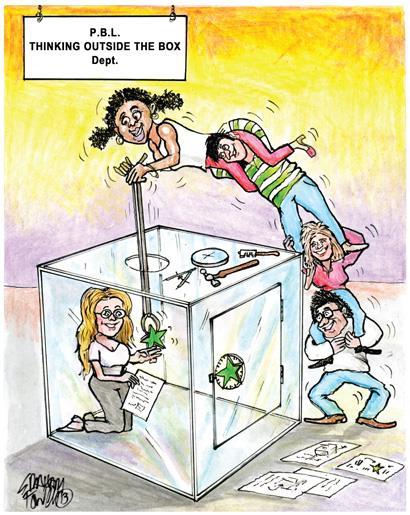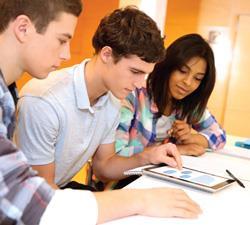Elizabeth Page explains how a problem-based learning approach to chemistry module design helps students develop the skills they need for employment

Since the Dearing Report1 there has been an increased emphasis on the development of employability and transferable ('soft') skills in undergraduate programmes. Within STEM subject areas, recent reports concluded that universities should offer 'greater and more sustainable variety in modes of study to meet the changing demands of industry and students'.2 At the same time, higher education (HE) institutions are increasingly conscious of the sensitivity of league table positions on employment statistics and graduate destinations. Modules that are either credit or non-credit bearing are finding their way into the core curriculum at HE.
While the UK government and other educational bodies argue the way forward over A-level reform, universities must also meet the needs of their first year cohorts in terms of the secondary to tertiary transition and developing independence in learning.
Striking a balance
There is general concern within UK chemistry departments about students' increasing demands to know precisely what and how to learn in order to succeed academically. The secondary school experience, which generally consists of prescriptive specifications, has created a culture of learning for the examination rather than developing an understanding of the subject. In the limited time available for teaching an A-level course, teachers have little choice but to optimise both examination results and league table performance. The outcome, in many cases, is students who are unable to take responsibility for their own learning by self-driven enquiry, and who then struggle with the independent study methods required for success in HE.
A new approach
Problem-based learning (PBL) is an approach that has been used for some time in health science disciplines and is enjoying increased attention in STEM subjects.3 It is known to stimulate and motivate students, enabling them to develop a deeper understanding as well as encouraging both independent and collaborative learning.
Well-developed and subject-specific PBL exercises provide an excellent vehicle for developing transferable skills, which frequently enjoy very low buy-in from students when delivered in a generic fashion. To address the issues described, we wanted to develop a series of skills-based modules running through the three years of the BSc course. Our aims were to produce undergraduates who were better able to cope with the style of learning and enquiry required for success in HE and better prepared for employment and the careers ladder.
Module design
Our first task was to find out students' biggest perceived differences between study at school and university. A survey revealed that the greatest changes were the increased requirement for self-motivation and independent study at HE, coupled with a decrease in the clarity of course and assessment requirements.
Next, we held a brainstorming session with first year tutors to agree the elements we felt essential in a module designed to stimulate independent learning. We wanted students to 'read' rather than remember the subject. This primarily involved students knowing how to access and process information and then apply that knowledge and understanding through problem solving. A new first year module was planned with aims to:
- Introduce students to open and closed types of problems and help them develop strategies for tackling them.
- Help students develop independent study skills so they can research a topic, process the information and solve a problem based on it.
- Help students develop time management, organisation and team-working skills.
- Give students practice and support in written and oral communication and help them develop good scientific writing skills.
The Chemical Education Group at the University of Reading set about designing a module comprised of various problems, each requiring a different skill set, mode of approach and assessment methods. We felt it important that the module content was rigorous and relevant: we deliberately focused problems on the more challenging areas of the first year curriculum that students were still to meet in lectures. We hoped students would learn by self-study and that further reinforcement of the concepts would occur at a later stage.

The first year module
The resulting module is 10 credits in weight and delivered through the first two terms of Year 1. It consists of three major challenges, one loosely based in each area of organic, inorganic and physical chemistry. Interspersed within the challenges are taught sessions on the various routine academic skills first year undergraduates need to develop, such as using library resources and online search facilities, good practice in referencing, citations and avoiding plagiarism, summarising and presenting information, writing abstracts, delivering presentations and keeping a laboratory notebook.
Students are divided into groups, strategically composed to ensure a mix of gender and ability at the beginning of the module. We use the Blackboard online learning software predominantly for delivering information and team-working via wikis, although students prefer to use their own space and regularly communicate through Facebook and other social media. The module provides a good opportunity to introduce students to the university online virtual learning environment.
Module structure
We start with a light-hearted icebreaker exercise (which is not assessed summatively) called 'Thinking outside the box'. Students make estimates of quantities and use basic scientific knowledge to solve open-ended problems with no right or wrong answer. Each team has a different problem that we derive mainly from 'A Question of Chemistry'.4
The teams have a week in which to organise themselves and their solutions to questions such as 'How much radioactivity is there in a banana?' and 'What mass of hydrogen gas would be needed to supply enough energy to boil water for all the cups of tea made in Britain each day?' The teams then prepare a five minute presentation on the way they solved their problem and deliver their answer in the following session.
The aim is for students to establish communication mechanisms, build relationships and experience some of the issues associated with team-working. Through these types of exercises, students should realise that not all problems have a precise answer. However, despite using approximations in quantities, we encourage students to consider the scale of their answers and the importance of units. Following this activity students attend a session delivered by a university study advisor where they reflect on the positive and negative aspects of group work and the role they and others played in the team.
The remainder of the module consists of three real-life chemistry challenges. These are designed so students can familiarise themselves with a range of skills including using library resources and search facilities, and how to work through a series of structured problems. The third task is perhaps one that students found most engaging.
The physical challenge
The third challenge focuses on the theory of vibrational and rotational spectroscopy - areas that are completely new to most of our first year students at this stage.
The problem is introduced with a video of a 'government minister' and a scientist being interviewed on television about the importance of national research platforms such as the Diamond Light Source synchrotron in Oxfordshire. The minister is exposed during the interview as being unable to explain the real value or importance of the facility and the scientist ultimately uses the concept of a matchbox to explain to the minister and the public the relative size of a molecule.
The challenge for the student teams is to prepare a briefing paper for the minister explaining and demonstrating some fundamental uses of vibrational and rotational spectroscopy so that next time he is asked to justify public spending on such a facility he can give a scientifically sound reply.
The teams research the basic theory involved and are given infrared (IR) and microwave spectroscopy data to enable them to work out the bond length and strength of a diatomic molecule and therefore how many such molecules would fit in to a matchbox. At this point students have met IR at A-level and recorded spectra in the lab but have not been introduced to the theory of vibrational or rotational spectroscopy.
The teams are given carefully designed instructions that point them in the direction of suitable reference material in textbooks and other sources. They have to handle data sets using Microsoft Excel and apply appropriate equations to derive their results. Units and exponents are important and they are asked to consider whether the values they obtain are sensible.
Finally they are asked to design an experiment to demonstrate to the minister the relative bond strength in their molecule compared to a rubber band. The task is challenging and students are assessed by a final group report and presentation on some aspect of their workings. The class results are compiled using a wiki and students have to determine if there is a relationship between bond length and strength by plotting a suitable graph. Any erroneous points are easily exposed!

Writing skills
A valuable part of the module is an exercise in writing a précis of a scientific article. Students are assigned an article from Education in Chemistry, on a contemporary scientific issue, and are asked to write a 400 word summary of the content. Student feedback shows that this is a most valuable component of the module. For many students scientific writing skills are poorly developed and there is limited time within chemistry programmes to dedicate to report writing and feedback on style and grammar. However, this exercise results in short and discrete submissions that are quickly and easily assessed and which can generate extremely useful feedback to students on individual writing skills.
Assessment
Summative assessment of the module is based on the various outputs and students have commented that this is something they value as it allows different skills and abilities to be rewarded.
One concern with a module that relies heavily on teamwork such as this is how to manage freeloaders - students who fail to contribute to team efforts. Students are rightly cautious of individual marks that are derived from teamwork. To allay these fears, each of the team marks is adjusted following peer assessment of team members by individuals. We use an algorithm to assess the different contributions of each team member as positive, neutral or negative and these are converted to scaling factors that allow us to generate an individual score from the group mark. The final marks are compared with each student's contribution to wikis, presentations and other visible outputs to ensure the scaling is valid. With this knowledge, students have a degree of confidence in the final marks and the process.
Student benefits
The module is now in its third year and we have some evidence to show that it is effective in helping undergraduates develop the skills required for employment. Second and third year students cite examples of good practice in their course from this module and evaluations are far more positive than for our previous more generic 'Career Management' module. Students have reported that the course has helped them answer interview questions such as 'How have you overcome problems in a group where one member has not contributed as expected?' and 'Give examples of a problem you have struggled to solve and how you succeeded'. In addition, end of module test scores for second year students on the spectroscopy course that follows this module have improved by an average of around 19%. The module encourages the use of the RSC Undergraduate Skills Record5 (USR) to track progress in individual skills. The availability of the online USR has made recording skills for chemistry students far more accessible.
In terms of transferable skills, students rate the physical module most useful in helping them develop team-working skills, in particular being assertive and communicating ideas to the group. One student commented the module was useful for 'teaching me to work in a group and take a role as a team leader' although several students comment that they prefer independent work rather than teamwork. The other skills that are highly rated are writing summaries and giving presentations. Both these attributes are key for success later in the course and in employment but are skills that are time-consuming to assess and provide feedback on for large numbers.
Transferable concepts
Although these modules have been designed for chemistry undergraduates, the concepts are transferable to any discipline. A full resource pack has been developed with guidance on how to set up an equivalent module from scratch and is available online.6 This web site contains a full set of resources and suggestions on how to schedule the module, through to managing and assessing group work and designing effective assessment and feedback strategies. The resource pack was produced with help from the centre for development of teaching and learning at the University of Reading and funding from a University Teaching Fellowship.
Elizabeth Page is senior lecturer in chemistry education and school director of outreach at the University of Reading, UK
Acknowledgements
The author would like to thank the members of the Chemical Education Group at the University of Reading who have worked towards the success of the module and who were recognised by a University Team Teaching award in 2012. Thanks also go to project officers Liz Tracey and Sally Wade for their work on setting up the module.
Downloadable Files
Thinking out of the box - skills for work
Download this article as it originally appeared in Education in Chemistry
PDF (227k)
PDF files require Adobe Acrobat Reader
References
- R Dearing, Higher education in the learning society. London: National Committee of Inquiry into Higher Education, HMSO, 1997
- South East Universities Biopharma Skills Consortium Project, Final report, 2010 (http://bit.ly/145v0O4)
- D P Williams et al, Chem. Educ. Res. Prac., 2010 11, 33 (DOI: 10.1039/C001045F)
- J Garratt et al, A question of chemistry: creative problems for critical thinkers. Harlow, UK: Pearson Education, 1999
- www.rsc.org/usr
- http://bit.ly/145wPdH









No comments yet